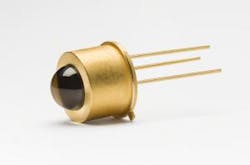Optan UVC LED technology increases lifetime and light output fivefold; target is spectroscopy
| Fabricated on AlN substrates, Optan LEDs emit at peak wavelengths from 250 to 280 nm. (Image: Crystal IS) |
Crystal IS (Green Island, NY) has unveiled Optan, which the company says is the first commercial semiconductor based on native aluminum nitride (AlN) substrates. The resulting UVC LEDs made from Optan emit at peak wavelengths in the 250-280 nm range and have light outputs and lifetimes five to ten times greater than previous UVC LEDs, says Hari Venugopalan, director of global product management at Crystal IS.
Crystal IS, which was acquired by compound-semiconductor maker Asahi Kasei (Tokyo, Japan) in 2011, is a spinoff of Rensselaer Polytechnic Institute (RPI; Troy, NY).
Fewer defects
Optan achieves increased LED performance by significantly reducing defects compared to growing LEDs on sapphire, says Venugopalan. Shortening the wavelength of gallium nitride (GaN)-based LEDs requires the addition of more and more Al, which increases the lattice mismatch between the LED semiconductor and the sapphire substrate. The extremely short wavelength of UVC LEDs worsens the mismatch. In contrast, the Optan AlN substrate has little mismatch with UVD LED semiconductor material.
Another advantage of Optan is the longer LED lifetimes it leads to, says Venugopalan. For example, an Optan-based UVC LED running at a high current of 100 mA has a lifetime on the order of 3000 hours; at lower currents, the lifetime can be extended to 8000 hours.
Bright UVC LEDs can be used to increase the detection sensitivity of absorption spectroscopy, which is used for many purposes ranging from the monitoring of chemicals in pharmaceutical manufacturing to the analysis of drinking water. Previously, many UVC applications have had to rely on traditional UV lamps such as deuterium and xenon flash lamps, with their lifetime limitations, high cost, bulk, and complexity.
Water analysis
Water-quality monitoring sensors are becoming increasingly important for detecting chemicals in water from fracking, the use of treated wastewater, and even potential terrorism threats.
One example is hydrocarbon monitoring in water, such as in areas near marinas and oil platforms, as well as in spill-affected waters. The traditional approach, grab sampling and testing by gas chromatography (GC), has a detection limit of 1 part per million (ppm) of oil in water; in addition, the sample must be made gaseous for detection, which doesn't allow for real-time detection, for example during an oil-spill-monitoring program.
Fluorescence spectroscopy avoids many of these problems, but the conversion from xenon or deuterium lamps to UVC LEDs as light sources has been slow due to low light output of early commercial UVC LEDs. The new UVC LEDs, however, are bright enough to facilitate this transition.
In a case study, WET Labs (Philomath, OR), which makes the WETStar fluorometer, evaluated the Crystal IS 280 nm UVC LED in the instrument. Testing showed that the WETStar fluorometer with the UVC LED source achieved a detection limit of 36 parts per billion (ppb) for oil dispersed in water; the response was linear for oil concentrations of up to 300 ppm (four orders of magnitude).
The Optan LEDs are currently available in peak wavelengths from 250 to 280 nm, and power bins from 0.5 mW to 2 mW. Full availability for all bins under 3 mW is anticipated for next quarter, with higher power bins (3 to 4 mW) available in fall 2014.
For more info, see www.cisuvc.com.
